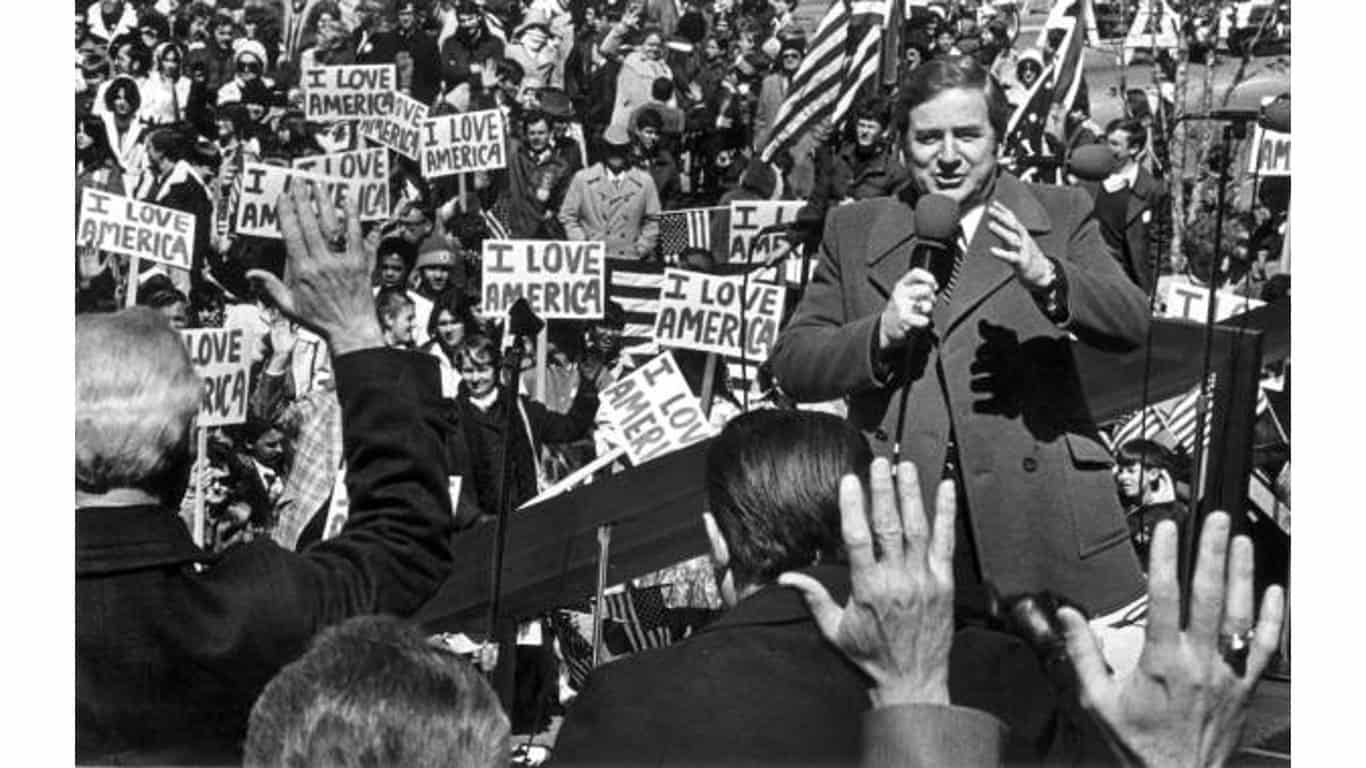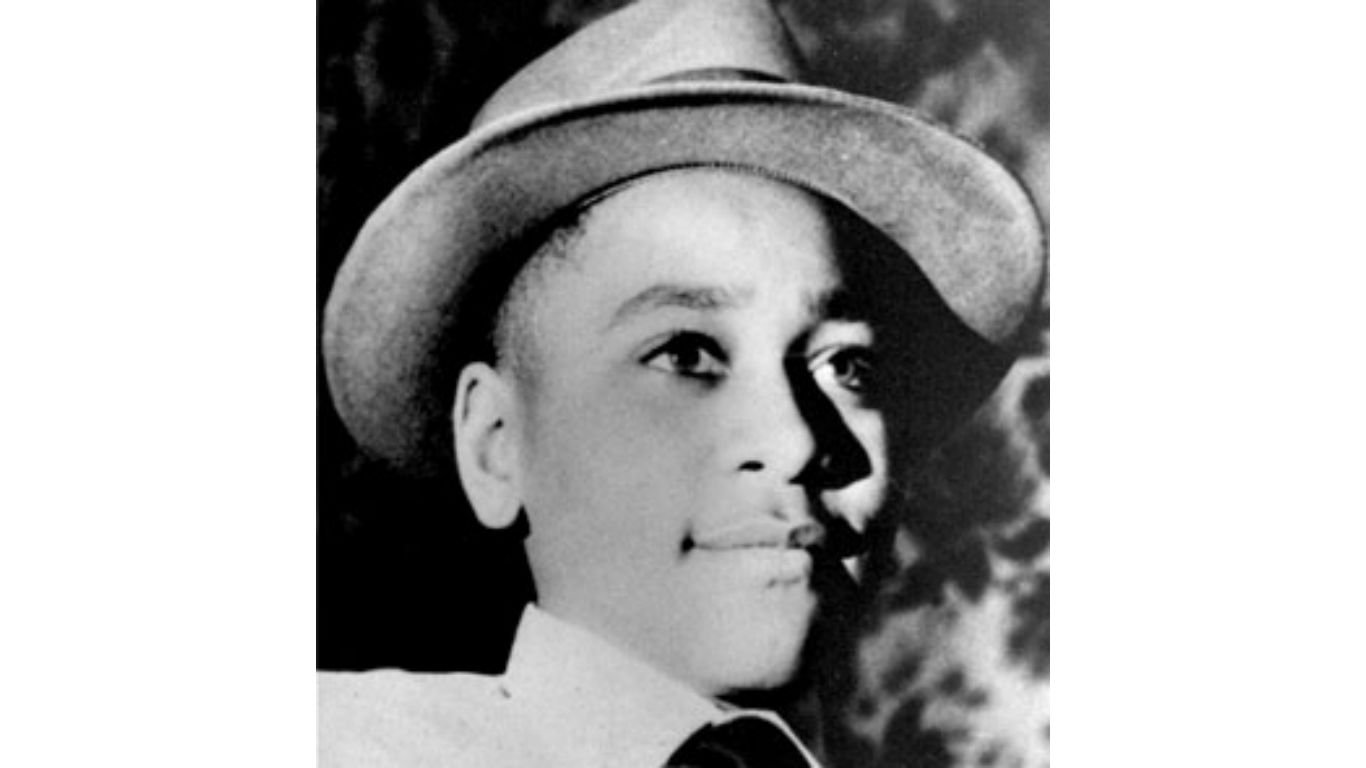The most famous trials in history go beyond just recounting verdicts passed on notable and often notorious individuals. They provide insights into a society’s pursuit of fairness and justice and can also reveal a darker side of human nature.
24/7 Tempo compiled a list of the most famous trials of all time by using material from sources such as Famous Trials, History, Encyclopedia.com, PBS, CNN, Vanity Fair, and the FBI. We exercised editorial discretion to select trials and their outcomes that had particularly significant historical or cultural implications.
Religious themes dominated many of history’s earliest notable trials, and many involved challenges to the Catholic Church. Martin Luther faced trial and later excommunication for denouncing church corruption. Thomas More was tried for treason and beheaded for opposing King Henry VIII’s marriage to Anne Boleyn, which challenged Vatican authority. Joan of Arc, now revered as France’s patron saint, was condemned for heresy by a religious tribunal in Rouen and subsequently burned at the stake.
Historical trials like those of Henry Wirz, the commander of Andersonville Prison during the Civil War, and Nazi officials at Nuremberg following WWII, impacted the legal system by establishing a new set of criminal charges that focused specifically on the rules of war and crimes against humanity.
Over the past 68 years, at least four well-known trials have underscored the racial divisions in the United States. In Mississippi in 1955, Roy Bryant and J.W. Milam were acquitted of the murder case of Emmett Till. The acquittal of Los Angeles police officers involved in the beating of Rodney King triggered riots in the city. Verdicts in the trials of O.J. Simpson, acquitted of two murders, and George Zimmerman, acquitted in the shooting death of Trayvon Martin, deepened racial tensions nationwide. (Click here to read about 22 famous unsolved crimes in American history.)
Here are the most notorious trials of all time:
The Athenian court v Socrates
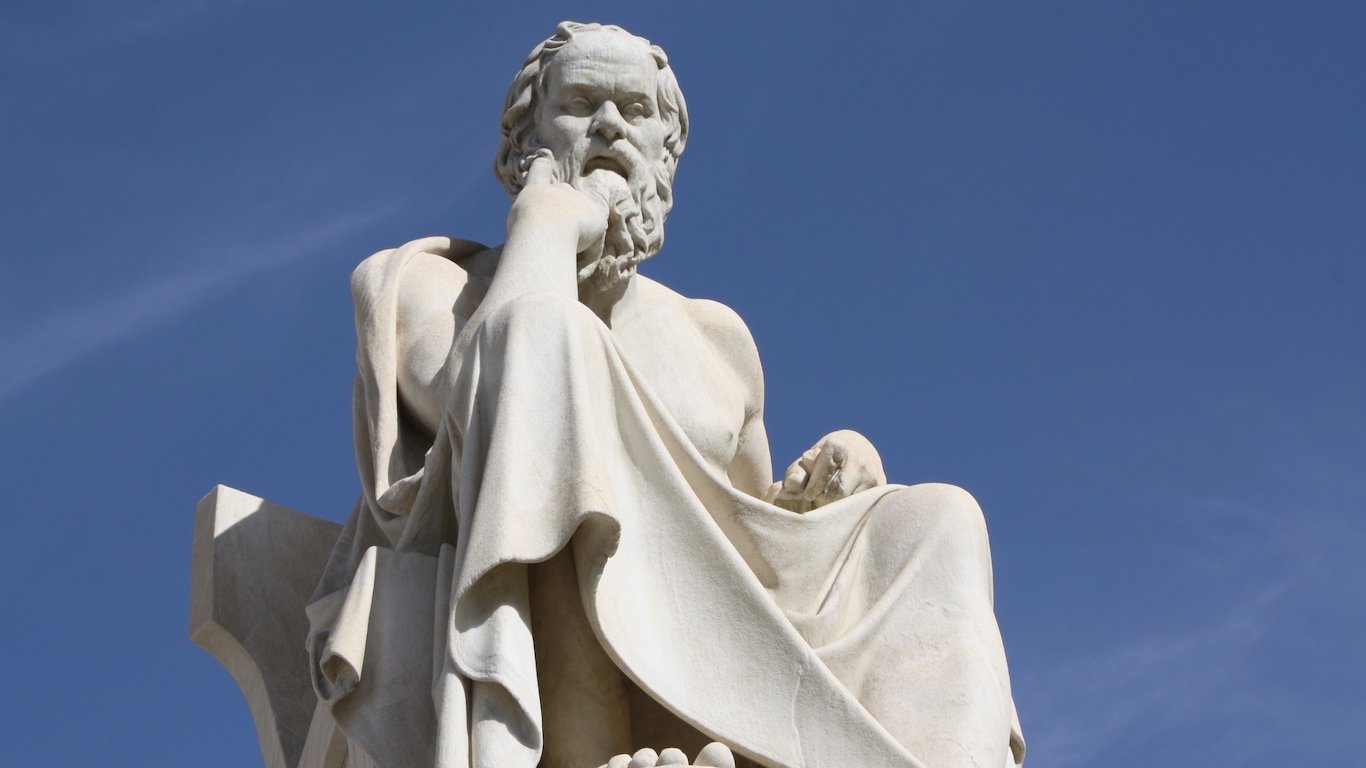
- Year of trial: 399 B.C.
- Charge: Impiety, corrupting youth
- Outcome for the defendant: Executed by poison
In 399 B.C., three prominent Athenians formally accused the seminal Greek philosopher Socrates of impiety for introducing new deities and corrupting the youth of Athens with his questioning and unconventional ideas. The Athenian democratic court, composed of 500 or 501 jurors, heard the case. Socrates defended his actions, arguing that his philosophic inquiry was in accordance with divine wisdom and therefore did not constitute impiety. Despite his defense, the jury found Socrates guilty. He was sentenced to death by drinking poison hemlock. His supporters urged him to flee Athens, but Socrates refused to flout the law.
Jewish high priests v Jesus Christ

- Year of trial: 30 or 33 A.D.
- Charge: Treason, blasphemy
- Outcome for the defendant: Executed by crucifixion
In the year 30 or 33 A.D. (sources differ), Roman soldiers and Jewish officials arrested Jesus of Nazareth, accusing him of treason – though his real offense was seen to be blasphemy (which wasn’t a crime under Roman rule), a charge based primarily on his claim of being the Son of God and the Messiah. He was tried before the Sanhedrin, a judicial tribunal composed of elder rabbis. Seeking a death sentence, they then presented Jesus to Pontius Pilate, the Roman governor of Judaea. There was a tradition that one condemned prisoner could be given amnesty for Passover. Pilate, finding no guilt in Jesus, offered to release him – but the assembled mob demanded the release of Barabbas, a criminal, instead. Under pressure, Pilate handed Jesus over for crucifixion, a common form of Roman execution.
The Catholic Church v Joan of Arc
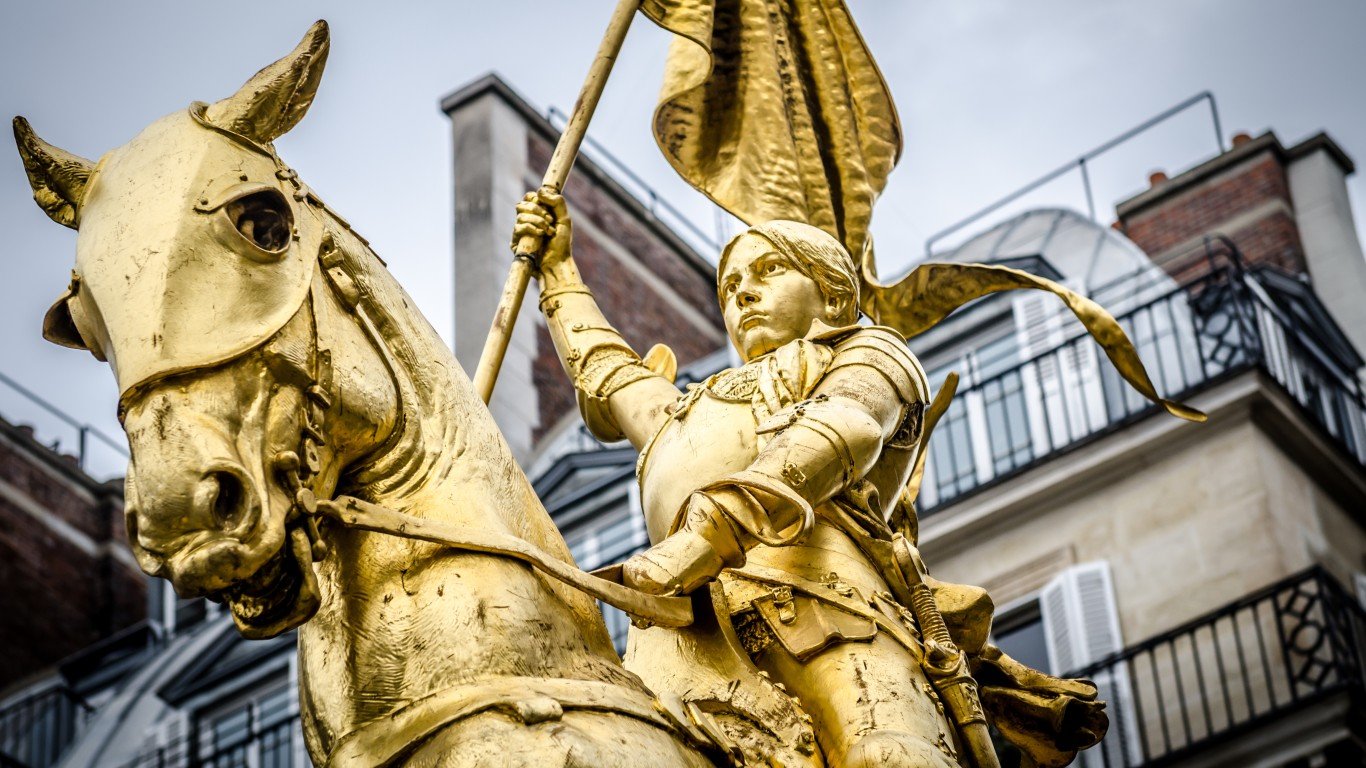
- Year of trial: 1431
- Charge: Heresy and other crimes
- Outcome for the defendant: Executed by burning at the stake
Joan, a young woman who had led the French army to important victories over the English during the Hundred Years’ War, was captured and turned over to her enemies, who charged her with heresy based on her claims of divine guidance and her refusal to submit to the Church’s authority. At the instigation of theologians at the pro-English University of Paris, she was handed over to an English liturgical tribunal sitting at Rouen. Convicted, she was given the chance to avoid execution by signing a document renouncing her beliefs. She signed, but subsequently changed her mind and on May 30, 1431, she was burned at the stake. At a posthumous retrial in 1456, the verdict against her was overturned and she was declared a martyr. The Church canonized her in 1920, and today she is revered as the patron saint of France.
Catholic Church v Martin Luther
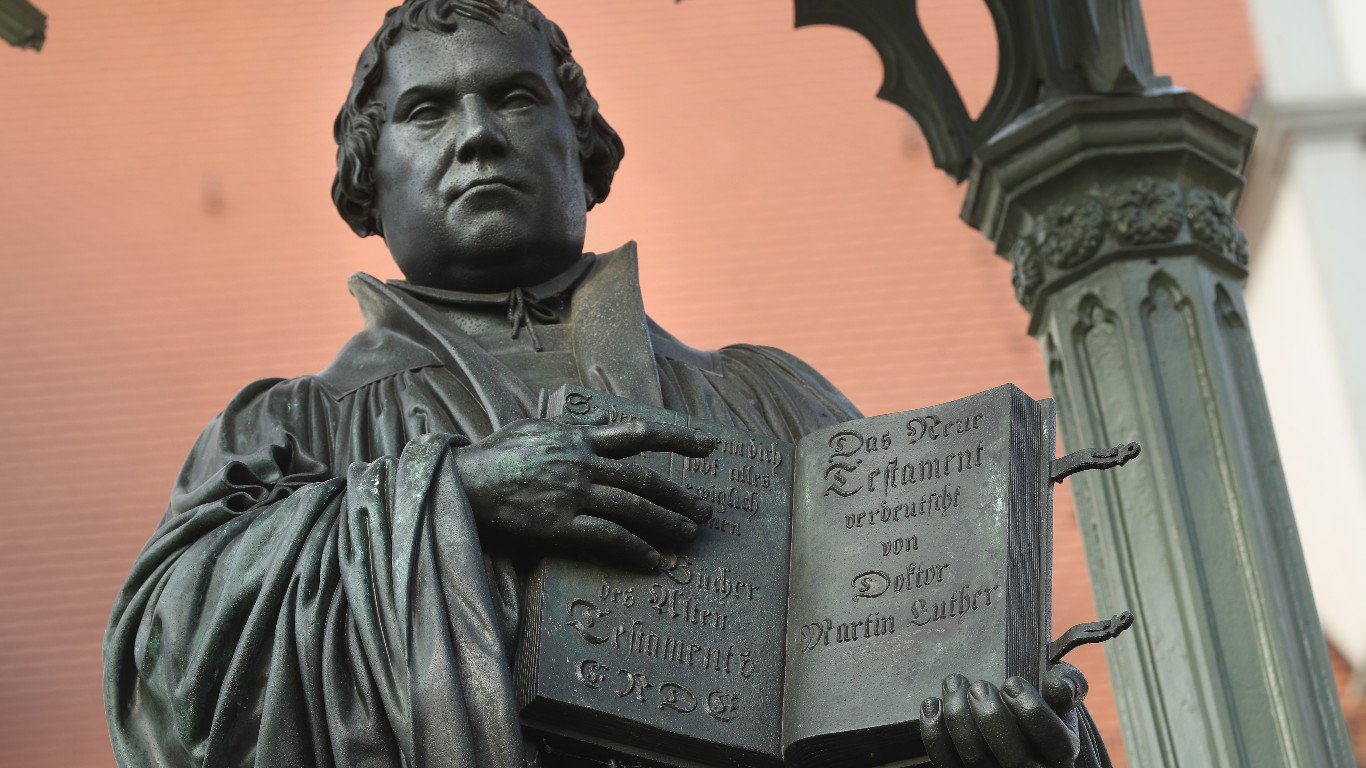
- Year of trial: 1521
- Charge: Heresy
- Outcome for the defendant: Excommunicated from the Catholic Church
In 1521, Martin Luther, a German theologian, was called to the Diet of Worms, a formal deliberative assembly of the Holy Roman Empire, to respond to charges of heresy. His 95 Theses had challenged the authority of the Catholic Church, especially its teachings on indulgences. Despite pressure, Luther refused to recant his writings and beliefs, famously stating, “Here I stand, I can do no other.” Following his refusal, Luther was declared an outlaw and a heretic. The Edict of Worms, issued by Emperor Charles V, banned his writings and called for his arrest. However, Luther found protection with Prince Frederick the Wise and continued to spread his anti-Catholic ideas, significantly contributing to the Protestant Reformation.
Crown of England v Thomas More
- Year of trial: 1535
- Charge: Treason
- Outcome for the defendant: Executed by beheading
A prominent English lawyer, More was put on trial for treason by King Henry VIII and the Crown for refusing to recognize the King as the supreme head of the Church of England. More was tried at Westminster Hall and found guilty, largely due to the false testimony of Solicitor General Richard Rich, who claimed that More had denied Parliament’s authority to grant the King ecclesiastical supremacy. More was sentenced to death based on Rich’s perjured evidence. He was beheaded on July 6, 1535, steadfastly adhering to his religious principles despite facing execution. His unwavering faith and conviction in the face of death led to his canonization by the Catholic Church in 1935.
Catholic Church v Galileo Galilei
- Year of trial: 1633
- Charge: Heresy
- Outcome for the defendant: Sentenced to house arrest for life
The trial of Galileo Galilei was a notable event in the history of science. Galileo, an Italian astronomer, was accused of heresy for his support of heliocentrism, the theory – whose origins dated back to Ancient Greece – that the Earth revolves around the Sun. This theory contradicted the Church’s geocentric model, which held that the Earth was the center of the universe. The Inquisition tried Galileo, who was forced under threat of torture to recant his views and was subsequently placed under house arrest for the rest of his life. The Church eventually acknowledged its error: In 1992, Pope John Paul II formally admitted the Church’s mistake in condemning Galileo.
Town of Salem v accused witches

- Years of trials: 1692-1693
- Charge: Witchcraft
- Outcome for the defendant: Executed by hanging or being pressed to death with stones
The Salem Witch Trials of 1692 in the town of Salem, Massachusetts, were a series of prosecutions of people accused of witchcraft. The trials spurred mass hysteria and fear, and led to the execution of 19 people. The accused were charged with “maleficium” – the crime of evil deeds through magical means, essentially witchcraft. The primary evidence against the accused came through “spectral evidence”, or the testimony of the accusers claiming to see the spirit of the witch harming them or others. The trials ended in May 1693 when Massachusetts governor William Phips disbanded the court and pardoned those still awaiting trial.
United States v John Brown
- Year of trial: 1859
- Charge: Murder, treason, inciting insurrection
- Outcome for the defendant: Executed by hanging
The John Brown trial of 1859 was a significant event in the prelude to the Civil War. A militant abolitionist, Brown was charged with treason against the Commonwealth of Virginia, murder, and inciting a slave insurrection, all stemming from his raid on the federal armory at Harpers Ferry, Virginia (now West Virginia). The raid, which aimed to seize weapons to arm an uprising of the enslaved, was unsuccessful and resulted in Brown’s capture. The trial was swift, and Brown was found guilty on all counts and hanged.
United States v the Lincoln conspirators
- Year of trial: 1865
- Charge: Insurrection
- Outcome for the defendant: Four conspirators executed by hanging, four imprisoned
Following the assassination of President Abraham Lincoln at Ford’s Theatre on April 15, 1865, eight defendants were charged with conspiracy to simultaneously murder him, the vice president, and the secretary of state. (The other assassination attempts failed; the man who actually shot Lincoln, John Wilkes Booth, was himself shot and killed while resisting arrest.) After a military tribunal, all eight were found guilty. Four were sentenced to death by hanging – including boarding house owner Mary Surratt, who was the first woman to be executed by the federal government – while three received life in prison and one got six years.
United States v Henry Wirz
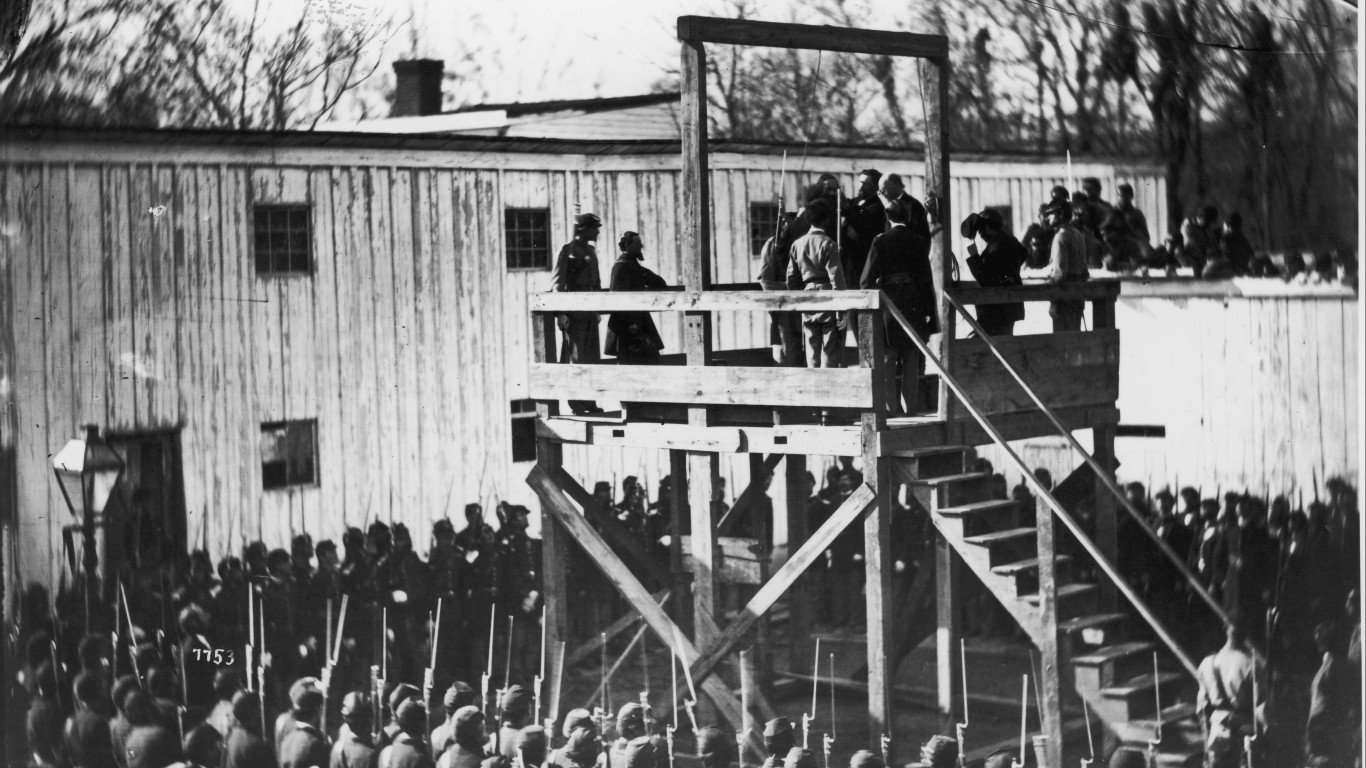
- Year of trial: 1865
- Charge: Violation of the rules of war
- Outcome for the defendant: Hanged
The 1865 trial of Confederate officer Henry Wirz was a landmark legal case. Wirz, who had been commandant of the notorious Civil War prisoner-of-war camp in Andersonville, Georgia, was charged with conspiracy and murder, since many Union soldiers under his jurisdiction at the camp died from disease and starvation. At the first war crimes trial in American history, Wirz’s defense unsuccessfully argued that he was “just following orders.” The military tribunal hearing the case found Wirz guilty on all counts, sentencing him to death. Hanged in November 1865, he was the only Confederate to be executed for war crimes.
Town of Fall River v Lizzie Borden
- Year of trial: 1893
- Charge: Murder
- Outcome for the defendant: Acquitted
In 1893, Lizzie Borden, a resident of Fall River, Massachusetts, was put on trial for the brutal ax murders of her father and stepmother, Andrew and Abby Borden. The case quickly garnered national attention due to its gruesome nature. The prosecution argued that Borden, motivated by family conflicts and a potential inheritance, committed the murders. However, the defense pointed out the lack of physical evidence linking her to the crime. The trial included testimony from pharmacists who said Lizzie had bought poison from them and from the family doctor, who took her side. The jury deliberated for less than two hours before acquitting Borden. Despite her legal vindication, public opinion remained divided, and Borden lived the rest of her life in Fall River, under a cloud of suspicion.
Republic of France v Alfred Dreyfus
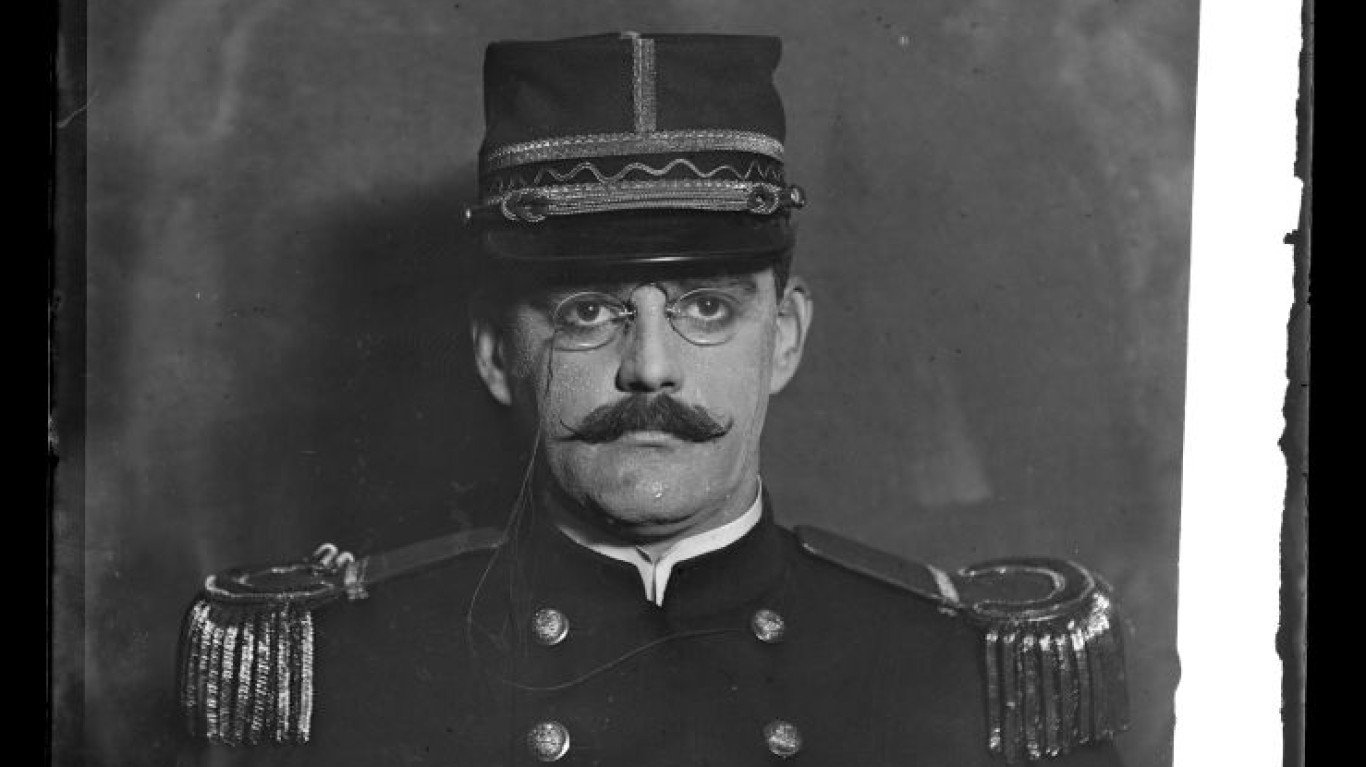
- Year of trial: 1894
- Charge: Treason
- Outcome for the defendant: Imprisoned
The infamously known Dreyfus Affair began with the trial of Alfred Dreyfus, a French artillery officer of Jewish descent, in 1894. Dreyfus was accused of passing military secrets to the German Embassy in Paris. The trial was marked by antisemitic undertones and questionable evidence, including a torn-up secret document found in a wastebasket, attributed to Dreyfus. Despite protesting his innocence, Dreyfus was convicted and sentenced to life imprisonment on the remote Devil’s Island off the coast of South America. However, ongoing public outcry and later evidence pointing towards another officer, Ferdinand Walsin Esterházy, led to a retrial. In 1899, Dreyfus was again convicted, but pardoned by President Émile Loubet. It was only in 1906 that Dreyfus was officially exonerated and reinstated into the military. The Dreyfus Affair deeply divided France and is remembered as a significant moment in the history of social injustice and antisemitism.
Oscar Wilde v Marquess of Queensberry

- Year of trial: 1895
- Charge: Defamation
- Outcome for the defendant: Queensberry acquitted; Wilde liable for legal expenses
In 1895, the famed writer Oscar Wilde brought a libel case against the Marquess of Queensberry. The Marquess had accused Wilde of being a “sodomite,” a grave charge given that homosexuality was a criminal offense in Britain at the time. Wilde, known for his sharp wit and flamboyant style, was a prominent figure in London’s artistic circles; the Marquess was the father of Wilde’s lover, Lord Alfred Douglas. The case quickly turned against Wilde when evidence supporting the Marquess’s accusation was presented. In a subsequent trial, Regina v Wilde (Regina, a reference to Queen Victoria, meant the British Crown), Wilde was ultimately convicted of “gross indecency” and sentenced to two years of hard labor.
Commonwealth of Massachusetts v Nicola Sacco and Bartolomeo Vanzetti

- Year of trial: 1921-1927
- Charge: Murder, armed robbery
- Outcome for the defendant: Executed by electrocution
Sacco, a shoemaker, and Vanzetti, a fish peddler, were Italian immigrants and self-proclaimed anarchists charged with the murder of a paymaster and a security guard during a payroll heist in South Braintree, Massachusetts. The trial amplified existing anti-leftist and anti-immigrant sentiments, and the case attracted international attention due to perceived biases against the defendants because of their political beliefs and immigrant status. Despite protests and appeals, Sacco and Vanzetti were found guilty and were electrocuted in 1927. The fairness of their trial and their guilt remain subjects of debate.
Cook County v Eight “Black Sox”

- Year of trial: 1921
- Charge: Bribery
- Outcome for the defendants: Acquitted but banned from baseball for life
The Cook County v Eight “Black Sox” trial of 1921 was a landmark case in the history of American sports. The eight defendants, players from the Chicago White Sox baseball team, were charged with conspiring to intentionally lose the 1919 World Series in exchange for bribes from gamblers. The players, dubbed the “Black Sox” as a measure of the dishonor they brought to their sport, included star athletes like “Shoeless Joe” Jackson and Eddie Cicotte. The trial was a national spectacle, drawing attention to the widespread issue of gambling in baseball. The jury acquitted all eight players, but the damage to their reputations was irreparable. In a separate decision, the baseball’s commissioner, Judge Kenesaw Mountain Landis, banned all eight from professional baseball for life, asserting that regardless of the trial’s outcome, they had stained the integrity of the game.
City of San Francisco v Fatty Arbuckle
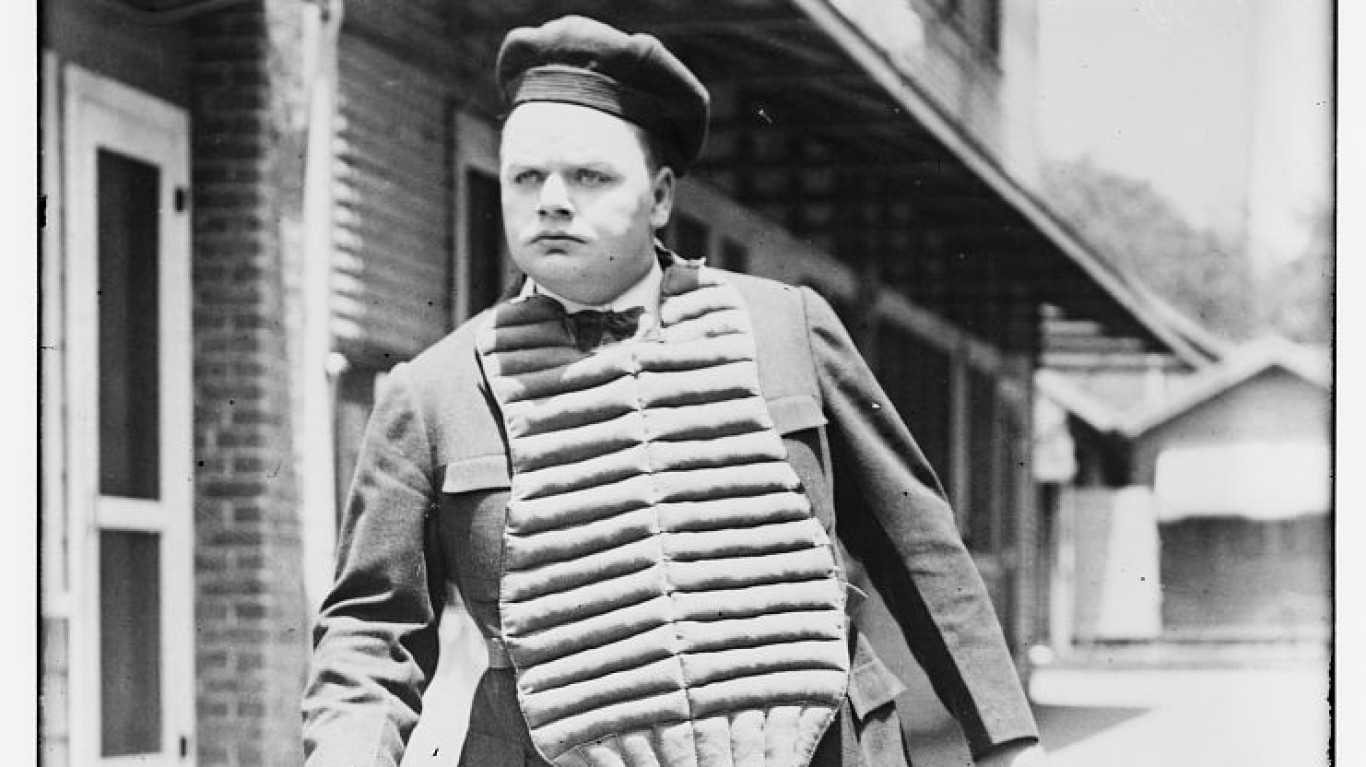
- Year of trial: 1921-22
- Charge: Manslaughter, rape
- Outcome for the defendant: Acquitted
In 1921, silent film star Roscoe “Fatty” Arbuckle faced manslaughter charges in a sensational Hollywood scandal trial, following the death of aspiring actress Virginia Rappe after a party both had attended. The highly publicized case saw Arbuckle accused of raping Rappe and inadvertently causing her death. The star was tried three times on the charges. Fueled by tabloid media coverage, the first two trials ended with hung juries unable to reach a verdict. In a third trial, Arbuckle was cleared of charges. However, the scandal irreparably damaged his career, as public opinion condemned him. The case marked an early example of how celebrity scandals and mob mentality could override due process, even after a court victory.
Cook County v Nathan Leopold and Richard Loeb
- Year of trial: 1924
- Charge: Murder, kidnapping
- Outcome for the defendant: Sentenced to life in prison
Nathan Leopold Jr., age 19, and Richard Loeb, age 18, both two wealthy students at the University of Chicago, were charged with the kidnap and murder of 14-year-old Bobby Franks. The case was notorious due to the defendants’ privileged backgrounds and their motive; they had no financial or personal reasons for the murder, but simply wished to commit “the perfect crime.” The lawyer for the defense was Clarence Darrow (soon to defend Tennessee school teacher John Scopes; see below), known for his passionate arguments against the death penalty. Despite Darrow’s efforts, Leopold and Loeb were both found guilty. However, they escaped execution and were instead sentenced to life imprisonment plus 99 years.
Government of Bavaria v Adolf Hitler
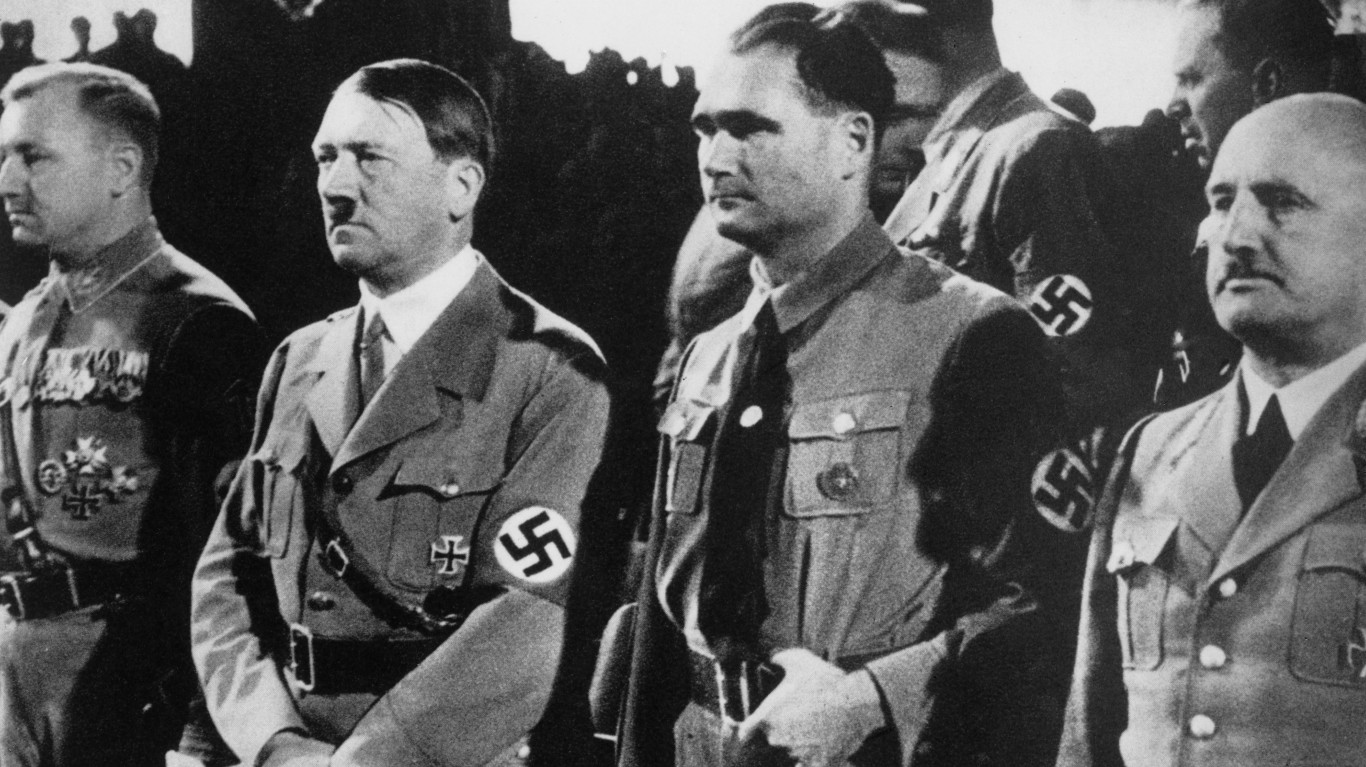
- Year of trial: 1924
- Charge: Treason
- Outcome for the defendant: Imprisoned
Hitler, along with other leaders of the National Socialist German Workers’ Party – the Nazis – was charged with high treason following the failed “Beer Hall Putsch” in November 1923, which attempted to overthrow the Weimar government. Hitler used the trial as a platform to propagate his political ideologies, gaining substantial national attention. In April 1924, he was found guilty. However, the court’s leniency resulted in a remarkably light sentence – five years in the Landsberg prison, of which he served eight months. This period of incarceration was pivotal for Hitler, as he used the time to write his book “Mein Kampf,” which outlined his political doctrine and future plans for Germany. It has been said that the course of the 20th century would have been very different had Hitler not been tried.
State of Tennessee v John Scopes
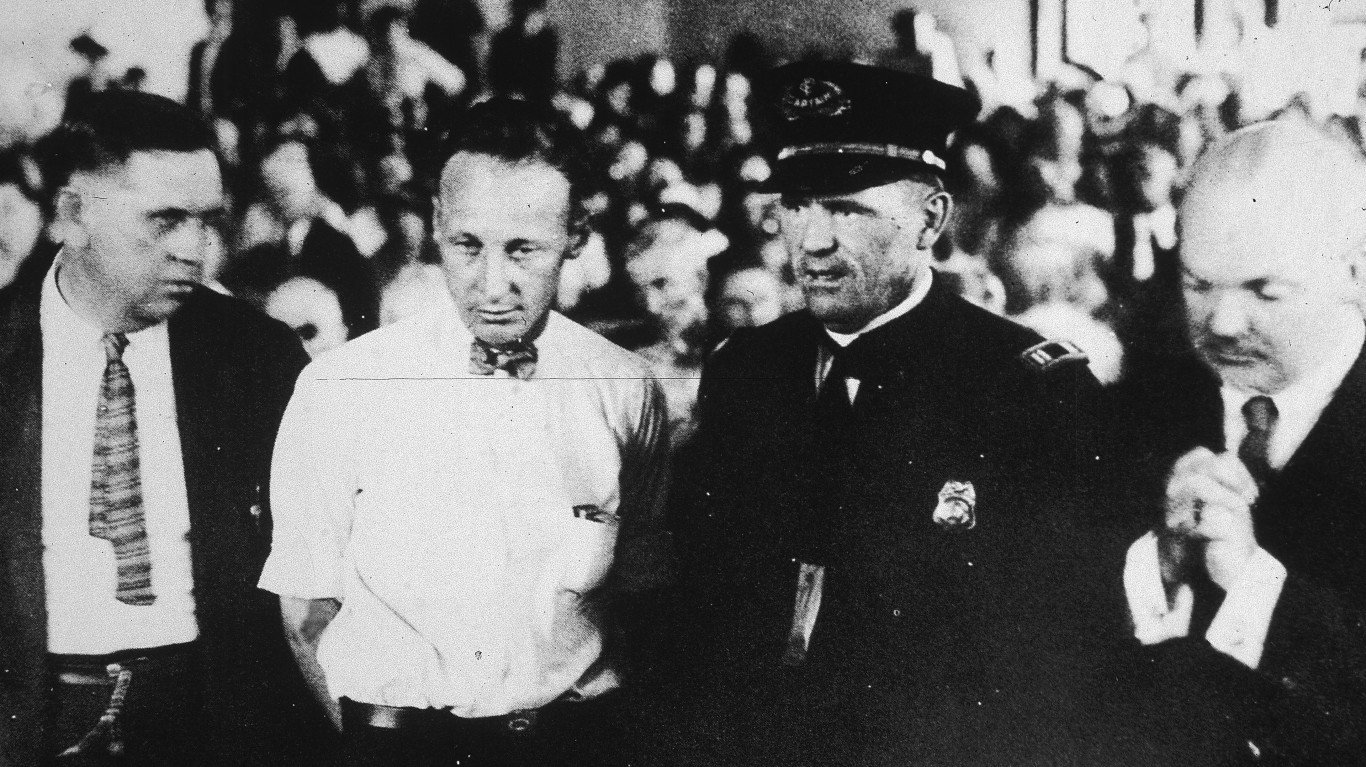
- Year of trial: 1925
- Charge: Teaching evolution theory
- Outcome for the defendant: Fined $100
The State of Tennessee v John Scopes, commonly known as the Scopes Monkey Trial, was a landmark case in 1925 that tested the legality of a Tennessee law prohibiting the teaching of evolution in public schools. The defendant, high school teacher John Scopes, was accused of violating this law by teaching his public-school students about evolution in a biology class. Especially notable because Scopes was represented by famed attorney Clarence Darrow, while the prosecutor was three-time presidential candidate William Jennings Bryan, the case became a public debate over science versus fundamentalist religion. Scopes was found guilty and fined $100, but the verdict was later overturned on a technicality.
United States v Al Capone

- Year of trial: 1931
- Charge: Income tax evasion
- Outcome for the defendant: Imprisoned
Capone, known for his criminal empire in Chicago during the Prohibition era, was not charged for his violent crimes, but rather for income tax evasion. The federal government, unable to gather sufficient evidence to prosecute him for his other suspected activities, pursued the tax angle, building a case on Capone’s lavish lifestyle and sizeable income. The trial lasted for several weeks, generating significant media attention. Ultimately, the jury found Capone guilty. He was sentenced to 11 years in prison, marking the downfall of one of America’s most notorious criminals.
State of New Jersey v Bruno Hauptmann
- Year of trial: 1935
- Charge: Murder, kidnapping of Lindbergh baby
- Outcome for the defendant: Executed by electrocution
Hauptmann, a German immigrant, was accused of the kidnapping and murder of Charles Lindbergh Jr., the two-year-old son of famous aviator Charles Lindbergh and his wife, Anne Morrow Lindbergh. The case was based on evidence that included the discovery of a large portion of the ransom money in Hauptmann’s possession. After a trial that lasted over a month, Hauptmann was found guilty. He was sentenced to death and executed in the electric chair at the New Jersey State Prison in April 1936.
The People v Errol Flynn
- Year of trial: 1943
- Charge: Statutory rape
- Outcome for the defendant: Acquitted
In 1943, Hollywood actor Errol Flynn faced serious allegations when two underage girls, Betty Hansen and Peggy Satterlee, accused him of statutory rape. Flynn pleaded not guilty to the charges. His defense team successfully questioned the girls’ morals and character and argued that they were motivated by financial gain. The jury, comprising mostly women, found Flynn not guilty on both counts. The trial had substantial impacts on Flynn’s career and personal life, despite his acquittal. Later the same year, Flynn was accused by 21-year-old Shirley Evans Hassau in a paternity suit. He settled out of court.
Allies v Nazi defendants

- Year of trial: 1945-49
- Charge: Crimes against peace, crimes against humanity, war crimes
- Outcome for the defendants: Some executed by hanging, others imprisoned, a few acquitted
The Nuremberg trials were judged by an international military tribunal assembled to prosecute Nazi officials for crimes committed during World War II. The original trial ran from November 1945 through October 1946, and was followed by 12 additional trials between December 1946 and April 1949. The first trial found three defendants not guilty, sentenced 12 to death, and gave the rest sentences ranging from 10 years to life. Those who were executed included Julius Streicher, Albert Speer, and Joachim von Ribbentrop. Martin Bormann was sentenced to death in absentia, and is thought to have committed suicide. Hermann Göring, also under a death sentence, committed suicide in jail. There were 177 defendants in the subsequent trials, mostly lower-ranking Nazi officials and collaborators of various kinds. Of these, 24 were sentenced to death, 20 given life sentences, and 98 sent to prison for shorter periods. The trials marked a significant moment in international law, establishing key principles for dealing with crimes committed during wartime.
United States v Julius and Ethel Rosenberg

Ethel and Julius Rosenberg became the first Americans executed by the federal government for espionage.
- Year of trial: 1951
- Charge: Espionage
- Outcome for the defendants: Executed by electrocution
The Rosenbergs, a married couple, were charged with conspiring to pass U.S. atomic secrets to the Soviet Union. The evidence against them included testimony from Ethel’s brother, David Greenglass, who worked at the Los Alamos National Laboratory, where the atomic bomb was developed. The Rosenbergs were convicted and sentenced to death. Their case drew international attention, with many arguing that the death penalty was too severe, particularly for Ethel, whose involvement was less clear. Despite numerous appeals and pleas for clemency, they were executed in 1953, becoming the first U.S. citizens put to death for espionage during peacetime.
Tallahatchie County v Roy Bryant and J.W. Milam
- Year of trial: 1955
- Charge: Murder of Emmett Till
- Outcome for the defendants: Acquitted
In this significant event in the civil rights movement, two white defendants, Roy Bryant and his half-brother, J.W. Milam, were charged with the abduction and murder of a 14-year-old African American boy, Emmett Till. Till, a Chicago native, was visiting relatives in Mississippi when he was accused of offending a white woman in her family’s store. The subsequent trial attracted national attention. An all-white jury acquitted Bryant and Milam after deliberating for less than an hour. The verdict sparked outrage and galvanized support for racial justice across the United States. Later, in an interview with Look magazine, Bryant and Milam, safe from re-prosecution due to double jeopardy laws, admitted to having killed the boy.
Soviet Union v Francis Gary Powers

- Year of trial: 1960
- Charge: Espionage
- Outcome for the defendant: Imprisoned
Francis Gary Powers, an American U-2 spy plane pilot, was captured by the Soviet Union in May 1960 after his plane was shot down while on a reconnaissance mission over Soviet airspace. This incident escalated the tensions of the Cold War as Powers was charged with espionage, a serious offense in the tense political climate of the time. After a highly publicized trial, Powers was found guilty and sentenced to three years in prison and seven years in a labor camp. However, in a diplomatic move, he was exchanged for a Soviet spy, Rudolf Abel, on the Glienicke Bridge between West Berlin and Potsdam, Germany, in February 1962, after serving less than two years of his sentence. (This event was famously depicted in Steven Spielberg’s 2015 movie “Bridge of Spies.”) In a bizarre twist of fate, Powers was killed in a helicopter crash in 1977 while working for KNBC in Los Angeles.
Cook County v Chicago Seven
- Year of trial: 1969-70
- Charge: Conspiracy and intent to incite riot while crossing state lines
- Outcome for the defendants: Acquitted on conspiracy charge; five guilty of intent to incite riot while crossing state lines
The defendants in this landmark case, known as the Chicago Seven trial, were activists Abbie Hoffman, Jerry Rubin, David Dellinger, Tom Hayden, Rennie Davis, John Froines, and Lee Weiner. (Initially, the group was called the Chicago Eight, but the trial of one defendant, Black Panther Party co-founder Bobby Seale, was separated due to his outbursts in court.) The charges against them concerned their protest activities during the 1968 Democratic National Convention in Chicago. The trial was marked by a circus-like atmosphere, with defendants and their attorneys often clashing with Judge Julius Hoffman. In February 1970, five of the defendants were found guilty of intent to incite a riot while Froines and Weiner were acquitted. However, all convictions were later reversed on appeal due to procedural errors and judicial prejudice.
The People v Charles Manson, et al.

- Year of trial: 1970-71
- Charge: Homicide
- Outcome for the defendants: Sentenced to life in prison
Manson, along with his followers, were charged with seven counts of first-degree murder and one count of conspiracy to commit murder. The charges stemmed from the infamous Tate-LaBianca murders, which occurred in August 1969. The prosecution argued that Manson had orchestrated the murders to incite a race war, which he called “Helter Skelter,” after the Beatles’ song. Manson and three of his followers were found guilty on all counts, and a fourth member of his “family” was convicted in a later trial. They were all initially sentenced to death, but their sentences were commuted to life in prison after California abolished the death penalty in 1972. One of Manson’s followers died in prison in 2009, and Manson himself died in 2017. Of the other three, one was released on parole this July, one has her next parole hearing in November , and one, the last to be convicted, was given a five-year denial of parole in 2021.
Jerry Falwell v Hustler Magazine
- Year of trial: 1984
- Charge: Libel and emotional distress
- Outcome for the defendant: Acquitted on libel charge; fined for emotional distress
This high-profile court case pitted Jerry Falwell, a prominent evangelical pastor, against Larry Flynt, the publisher of Hustler magazine. The trial revolved around a parody advertisement published in Hustler depicting Falwell having sex with his mother. Falwell sued Flynt for libel and emotional distress. However, the court ruled against Falwell on the libel charge, stating that the parody could not reasonably be understood as stating actual facts about Falwell. The jury did award Falwell $200,000 for emotional distress, but this decision was appealed to the Supreme Court, which unanimously overturned the award, ruling that public figures must prove that defamatory statements were made with “actual malice” to successfully sue on those grounds. This case bolstered the protection of free speech, even when it is offensive.
State of Wisconsin v Jeffrey Dahmer

- Year of trial: 1992
- Charge: Homicide
- Outcome for the defendant: Sentenced to life in prison
The trial was one of the most notorious criminal cases in American history. Dahmer, often referred to as the “Milwaukee Cannibal”, was charged with 15 counts of first-degree murder. The charges stemmed from a series of crimes committed between 1978 and 1991, which involved rape, dismemberment, necrophilia, and cannibalism. The trial focused heavily on Dahmer’s mental state. His defense team pleaded insanity, but the prosecution argued that Dahmer’s calculated actions and attempts to conceal his crimes demonstrated sanity. The jury rejected the insanity defense and found Dahmer guilty on all counts. He was subsequently sentenced to 15 consecutive life terms in prison without the possibility of parole. In addition to his other life sentences, Dahmer received a 16th life term for a previously unsolved murder in Ohio in 1978, before his Wisconsin killings. Dahmer was beaten to death by a fellow inmate at the Columbia Correctional Institution in Portage, Wisconsin, in 1994.
United States v John Gotti

- Year of trial: 1992
- Charge: Murder, racketeering, obstruction of justice
- Outcome for the defendant: Sentenced to life in prison
John Gotti, known as “The Dapper Don,” was the boss of the Gambino crime family in New York City. Gotti was charged with 13 crimes, including racketeering, murder, and conspiracy to commit murder. The trial was marked by intense media attention and allegations of jury tampering, which had resulted in his acquittals in previous trials. However, in this instance, the government’s case was bolstered by the testimony of Salvatore “Sammy the Bull” Gravano, Gotti’s right-hand man and a key witness for the prosecution. The jury found Gotti guilty on all counts. He was sentenced to life in prison without the possibility of parole. He died 10 years later in prison from throat cancer.
The People of the State of California v O.J. Simpson
- Year of trial: 1994-1995
- Charge: Homicide
- Outcome for the defendant: Acquitted
The O.J Simpson trial was one of the most publicized events in American legal history. Renowned former football player and actor Orenthal James “O.J.” Simpson was charged with the murders of his ex-wife, Nicole Brown Simpson, and her friend, Ronald Goldman. The trial, which lasted eight months, was broadcast nationally, contributing to a media circus surrounding its proceedings. Simpson’s defense team, often referred to as the “Dream Team” and included such celebrated attorneys as F. Lee Bailey, Alan Dershowitz, and Johnnie Cocran, argued that the Los Angeles Police Department had planted evidence to frame Simpson. After a highly contentious trial, Simpson was acquitted of all charges, leading to widespread debate and controversy over the verdict. The trial’s outcome continues to spark discussions about race, celebrity, and justice in America.
United States v Timothy McVeigh

- Year of trial: 1997
- Charge: Murder
- Outcome for the defendant: Executed by lethal injection
The Oklahoma City bombing of 1995, which resulted in 168 fatalities (including 19 children) and over 500 injuries, remains what the FBI calls “the worst act of homegrown terrorism in the nation’s history.” The man responsible, Timothy McVeigh, a former U.S. Army soldier, was charged with 11 federal counts, including conspiracy to use a weapon of mass destruction, use of a weapon of mass destruction, destruction with the use of explosives, and eight counts of first-degree murder for the deaths of federal law enforcement officers. After a jury trial, McVeigh was found guilty on all charges and sentenced to death. He was executed by lethal injection in 2001, marking the first federal execution in the United States since 1963.
State of Florida v George Zimmerman
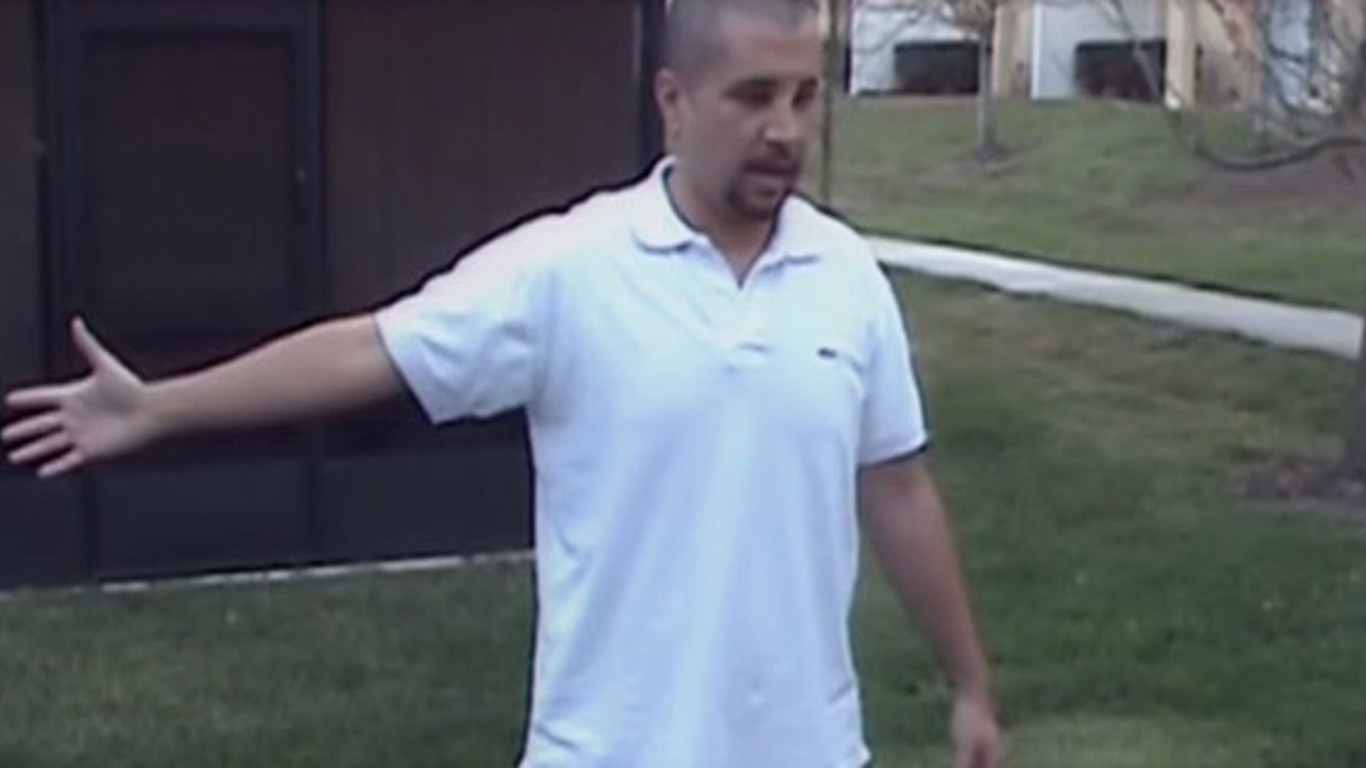
- Year of trial: 2013
- Charge: Homicide
- Outcome for the defendant: Acquitted
Zimmerman, a neighborhood watch volunteer, was charged with second degree murder for the fatal shooting of Trayvon Martin, a 17-year-old African American high school student, in Sanford, Florida. The case sparked nationwide protests and ignited discussions about racial profiling, self-defense laws, and gun control. Zimmerman claimed self-defense under Florida’s controversial “Stand Your Ground” law. After a three-week trial and over 16 hours of jury deliberation, Zimmerman was acquitted of all charges. The verdict further intensified the national debate over race, law enforcement, and justice in the United States.
